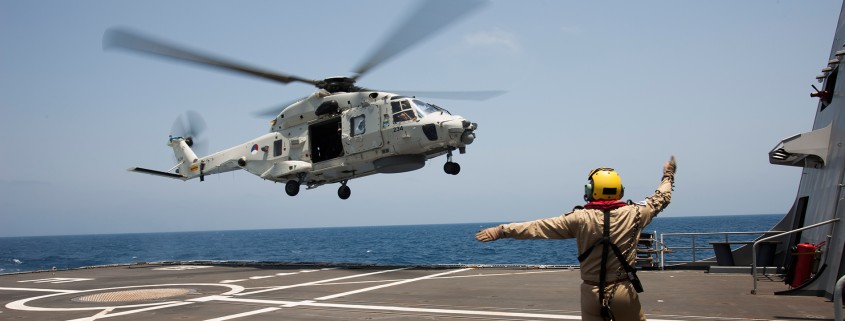Together with Dutch company AeroMath, NLR has developed a training course about their innovative qualification methodology for helicopter landings on ships. Thanks to this method, the costs of and time spent on the qualification programme can be reduced by approximately two-thirds. The course is intended for both manufacturers and users of helicopters and the ships they land on. It is also relevant for unmanned systems. The first course will start in March 2016.
The armed forces are an important target group. Helicopters serve as the ‘eyes and ears’ of many marine corps: they can go on reconnaissance missions, perform search and rescue operations, or contribute to mine-sweeping operations. In addition, helicopters can be used to convey goods and people from coast to ship and back, without the ship having to enter a harbour. This not only saves time, but is especially useful when no suitable port is near.
In order to adequately perform such operations, helicopters must be able to safely land on a ship under all conditions. Aspects such as Sea state and wind speed & direction play a major role in this regard. The characteristics of both the helicopter and the ship itself are decisive for the relevant safety margins. The basic principle is that the ship can continue their mission and stay in the convoy as much as possible. All such factors are taken into account in a Ship-helicopter qualification procedure, during which the operational limits are established for a specific ship-helicopter combination.
The training provided by NLR and AeroMath offers an introduction to the qualification process and all attendant steps. NLR contributes its knowledge of aerodynamics and aviation systems, while AeroMath contributes its operational expertise. The training course is intended for (navy) operators, shipbuilders and helicopter OEMs. It will enable helicopter OEMs to incorporate users’ requirements for ship-board operations into the design The course will also help shipbuilders to optimise their designs to the requirements of helicopter operators.
The objective of the course is to help participants to reduce the costs as well as the time required for the qualification process. Both the facilities and the qualification methodology of NLR and AeroMath play an important role. Part of the qualification process takes place in NLR’s wind tunnels, where various wind conditions can be simulated. This saves expensive flight and sailing hours. The helicopter’s characteristics are then carefully mapped, after which the operational limits can be established. This is followed by validation through field testing. Finally, NLR will issue a qualification advice to the aviation authorities.
For more info on and registration for the training visit our Helicopter-ship qualification training page.



